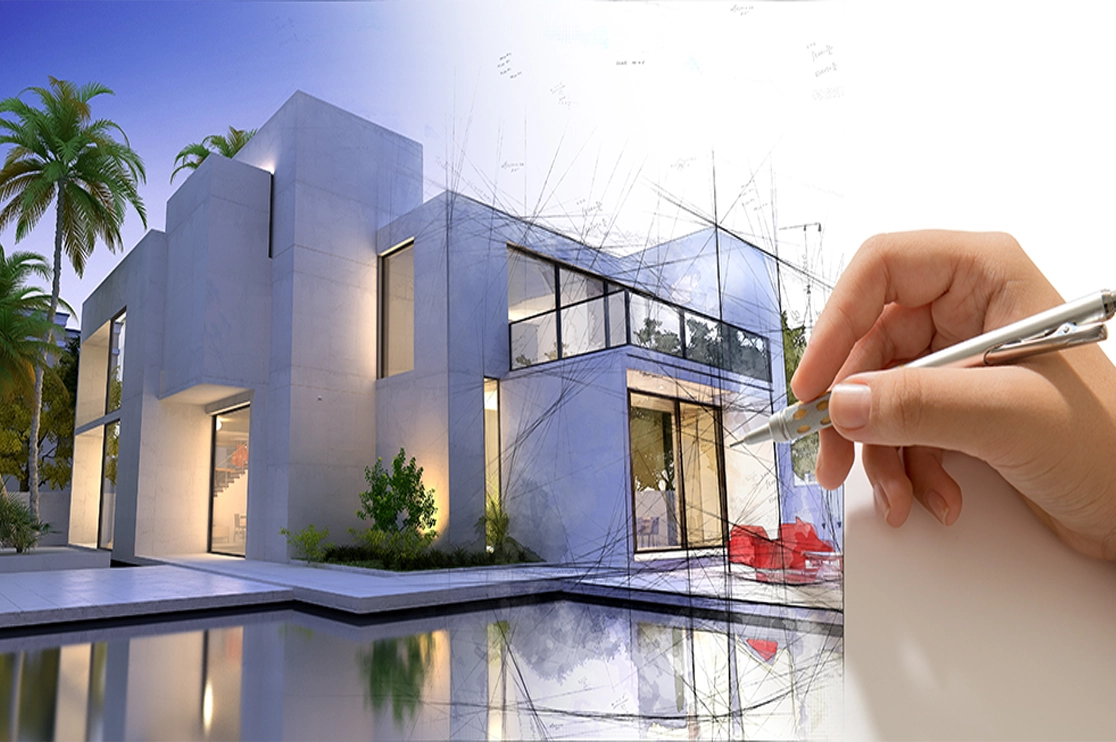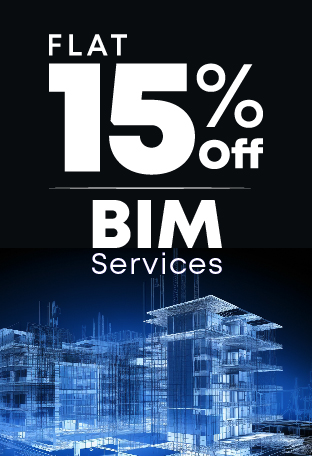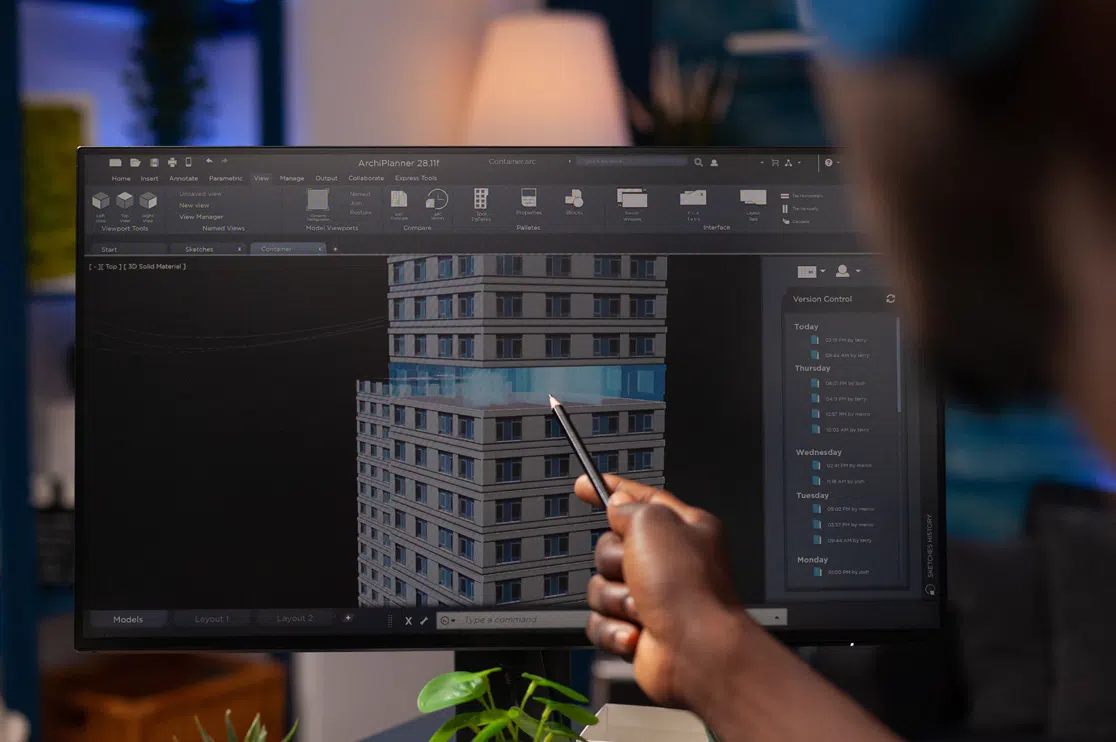Why has the adoption of Building Information Modeling (BIM) been slower in residential architecture projects compared to other types of projects? Furthermore, how can BIM for residential construction be beneficially realized for projects of all sizes?
Table of Contents:
- Introduction to BIM for Residential Construction
- Barriers to Adoption of BIM for Residential Construction
- Lack of Client Buy-in & Demand
- Nature of Design Complexity
- Lack of Focus and Marketing
- Economies of Scale
- It’s All About Funds
- Interoperability & Data Exchange Issues
- What is Building Information Modeling?
- Benefits of Adopting BIM for Residential Projects
- Marketing and Communication Tool
- Structured Information
- BIM LEED(s) Global Green Movement
- Future Outlook of Residential BIM
- Conclusion
Introduction to BIM for Residential Construction
Over the last few years, Building Information Modeling (BIM) has been one of the most visible aspects of a deep and fundamental change that is rapidly transforming the global construction industry.
- A McGraw Hill SmartMarket Report on BIM shows that 72% of BIM users say that BIM has impacted project internal processes.
- The Construction User’s Roundtable (CURT) has recommended that owners demand the utilization of BIM on their projects for effective collaboration and improved project quality.
- The Global Fraternity of Architects (GFA) touts BIM as the future of the construction industry. The AIA is actively redefining the practice of architecture to take advantage of this technology.
- In the 10th Annual BIM Report by NBS, it is noted that 73% of survey respondents used BIM in 2020, as opposed to 43% in 2011.
Despite BIM’s inexorable rise, the residential sector has been slow to embrace the concept. The majority of buzz around BIM is commercial-focused.
Is this because BIM is seen as a process for ‘big’ firms only? BluEntCAD presents the major reasons why the residential sector is facing barriers with BIM.
6 Majro Barriers to Adoption of BIM for Residential Construction
Residential construction practitioners respond in various ways about not adopting BIM modeling services. The primary reasons cited are a lack of owners’ demand for BIM, significant investment, perceived limited value of BIM, and economies of scale.
Lack of Client Buy-in & Demand
One of the biggest challenges is to obtain buy-ins from owners. Most residential owners are unwilling to pay for a complete set of high-quality plans.
As long as the drawings are turned in on schedule, they have no preference as to how the package is delivered ( that is, whether it is done in CAD or BIM). Without their buy-ins, it is much harder to “succeed”.
Nature of Design Complexity
There is a common belief that “smaller scale” equates to “fewer issues”.
“BIM is generally perceived as more applicable and profitable to larger, high-rise building projects. This user perception has been a strong impediment to BIM usage on small residential architecture projects,” corroborates Ravi Khanna, MRICS, Country Head – India, BCRE.s.
Lack of Focus and Marketing
Commercial BIM gets a greater degree of focus for one simple reason: marketing. And the largest BIM software providers, Autodesk and Graphisoft, focus primarily on commercial building projects.
Residential BIM users are rarely discussed, whether it is for architectural, HVAC, structural or energy analysis. So, the potential of BIM remains unknown to many residential building developers and owners.
Economies of Scale
The profit marginality between residential BIM and commercial BIM projects varies significantly.
Compared to commercial projects, residential BIM projects achieve fewer outcomes (based on marginal value vs. expenditures of time/resources vs. commercial structures).
A larger project scope is required to move from “marginal” benefits to “significant” benefits. Due to this, the residential sector is not ready to invest time, energy and resources into the new processes related to BIM.
It’s All About Funds
BIM implementation requires significant investments in technology, staff, and Revit training.
Moving from the CAD sphere to the BIM sphere demands powerful hardware and software, along with networks, servers, and high-speed telecommunications that support the process.
Generally, the additional hours and expenses that are required to put into the implementation become overhead, which is tough to manage in downturns.
When new jobs are hard to come by, residential owners and firms would rather hold on to their favorite CAD program to deliver until things start picking up.
Interoperability & Data Exchange Issues
The effort expended in moving data throughout the construction lifecycle is significant. BIM promises to improve data flow due to the nature of “modeling” vs. drafting.
However, in many cases the lack of complete adoption of BIM increases the complexities related to interoperability. A variety of national and international construction industry groups estimate the added costs of a project due to poor interoperability to be 15–30% of the costs of design and engineering.
Marc Goldman, Director of Strategy at BIM & VDC, the Blue Book, says that ” given the tight margins of the residential construction sector, there is little-to-no tolerance for adding complexities due to interoperability.”
What is Building Information Modeling?
Building Information Modeling (BIM) is a process that is carried through with the use of software.
The success of a BIM project depends on selecting the right BIM tools, such as Revit and ArchiCAD, and implementing them through strategic transition planning, i.e., management.
We can define BIM as a combination of three Ps: Process, Product, and Practice.
Building Information Modeling (project) = Process* + Product + Practice
Product = BIM-authoring Tool (Revit, ArchiCAD, Bentley, etc.)
Practice = Management (Strategic Planning of Transitioning)
*Where Process = Building + Information + Management
Benefits of Adopting BIM for Residential Projects
“Each building sector has its own complications which BIM can successfully remedy,” suggests Tim Beckman, Partner at CG Visions. Gary Lawes, owner, Jagged Edge Design Ltd., adds, “BIM could be applied to any project of any scale”.
BIM is quickly gaining acceptance on several institutional projects worldwide, and residential developers are also beginning to realize the benefits.
Many early adopters of BIM initially focused on applying the technology to large, complex projects. They saw BIM as a way to improve the design process.
However, residential owners are realizing that BIM is more of a method than a tool, and can be used throughout the practice, irrespective of the size of projects. Now, even most custom green-homes projects are being started in BIM.
There are several factors that are motivating non-adopters to use BIM:
- Increased productivity due to structured information
- Improved collective understanding of design intent
- Analysis and simulation capabilities (energy, cost, quantity)
- Improved accuracy and better project planning
- Better-performing buildings/infrastructure
- Cost estimates for early project certainty
- Enhanced operations, maintenance, and facility management
- Climate change and occupant health consciousness
- Economic pressures and stiff competition
Marketing and Communication Tool
BIM fosters collaboration, enabling “soup-to-nuts” cooperation among owners, architects, engineers, contractors, subcontractors, suppliers, trade professionals, and building operations/facilities personnel.
It ensures structured and methodical access to the right information in the right place and at the right time. It offers enough benefit for all types and sizes of projects—from small residential projects to large, complex commercial building projects. The advantages (and profitability) are inherent regardless of building type or size.
Structured Information
For developers, 3D modeling is critical to improving their business. Residential owners/developers more often need visual 3D than do commercial clients. Indeed, many clients don’t fully understand a flat 2D world.
When they see a space in 3D, they become more easily convinced. Building Information Modeling offers a tantalizing proposition: the ability to view the project clearly much before it’s built.
Thus, it saves a lot of waste, miscommunication, and frustration.
BIM LEED(s) Global Green Movement
Volatile and increasing energy prices, concern about climate change, and occupant health consciousness are influencing people around the globe.
People are advocating for decisive action to make societies green and sustainable. These demands have become paramount for commercial, institutional, and residential building projects.
Green evangelists are concerned about the current state of energy consumption and carbon emissions worldwide and are looking for a redirection of current construction and design approaches. BIM can be among the effective solutions for slowing climate change and reducing waste and carbon emissions.
Indeed, many nations have already implemented efforts to incorporate BIM.
- Many firms in the US and Canada are using Revit (a BIM-authoring tool) to design custom green homes and residential architecture projects.
- Wisconsin and Texas mandate BIM use for all new state projects to conform to high environmental and energy-efficiency standards.
- On the federal level, the US General Services Administration (GSA) necessitates BIM for spatial validation, and the US Army Corps of Engineers mandates that BIM be used for many of its standard building types.
- In Canada, some prefabricated home plants began using ArchiCAD and Revit and plan to use the MEP suite to include pipes in prefabricated floor panels.
- In Scandinavia, BIM-based fabrication of family homes is old news.
- While speaking at Autodesk’s BIM Conference last year, Paul Morell, chief construction adviser to the UK govt., indicated that bidders and contractors on future public building projects would be asked to use BIM. He also proclaimed that BIM would become a key part of the procurement of public buildings.
- The Singapore govt. has suggested that the engineering community use BIM on residential architecture and commercial building projects for construction productivity and improved work processes. In fact, back in 2010, the Building and Construction Authority (BCA) implemented the BIM Roadmap, with the goal for 80% of the construction industry to utilize BIM by 2015.
Future Outlook of Residential BIM
BIM has immense potential to improve the broad-scale construction project ecosystem and the outcomes for all parties.
Each stakeholder on a construction project has their own unique workflow and expectations. Thus, each also has a different value proposition regarding BIM, and therefore a different experience of business value.
In short, there is no how-to checklist that applies to every situation. However, Integrated Project Delivery (IPD) will likely play an important role in the construction industry and BIM is going to play a critical role in controlling the collaboration process.
Conclusion
When computers first came to the market, only large enterprises seemed to fully comprehend their usefulness. Now, practically, each child has her own computer. General contractors are increasingly mandating BIM and necessitating their subcontractors to provide drawings and other disciplines in BIM.
“It is true that an established decades-old platform (CAD) can’t be uprooted overnight,” suggests Tim Beckman. But nothing stays the same for long.
“It’s not the technology that makes our industry or any industry advanced; it’s people’s understanding of what it can do for them and how they can benefit from it,” says Florin O. Popa, Director – BIM Services, in Studios, LLC.
If you wish to implement BIM to reap its vast benefits, reach out to BluEntCAD. We serve large architectural and engineering companies, MEP subtraders, HVAC subtraders, fire subtraders, general contractors and design build contractors. Our BIM services include Scan to BIM, Revit modeling, and BIM clash detection. Contact us today!







 How AI BIM Modeling Shaping the Future of Residential Construction?
How AI BIM Modeling Shaping the Future of Residential Construction?  How BIM Services Enhance Collaboration, Design Choices, and Project Efficiency for Architects? – A Guide
How BIM Services Enhance Collaboration, Design Choices, and Project Efficiency for Architects? – A Guide  How is Artificial Intelligence in Construction Design Transforming Architectural Landscape?
How is Artificial Intelligence in Construction Design Transforming Architectural Landscape?  BIM Coordination Benefits for Contractors in the Preconstruction Stage
BIM Coordination Benefits for Contractors in the Preconstruction Stage